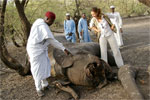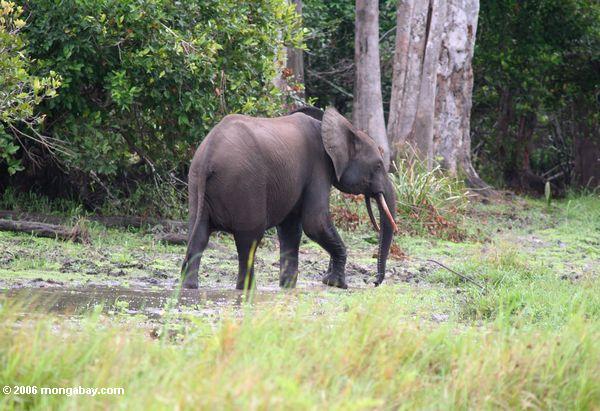Forest elephant in Gabon. Photo by: Rhett A. Butler.
One of the difficulties plaguing law enforcement and authorities when it comes to tackling elephant poaching is determining where the ivory originates. Now, research published in the journal Evolutionary Applications, has found a new way of tracking ivory back to wild elephants populations: forensic genetic studies.
Looking at mitochondrial DNA (mtDNA), scientists have been able to divide Africa’s wide-ranging elephant population into eight distinct groups. This has allowed them to determine the country of origin for ivory 62 percent of the time, and in some cases up to 84 percent.
Scientists focused on the elephants’ mtDNA, since this is transmitted only be females, which generally don’t move far from their birthplace as opposed to males.
Once governments have a better idea just where elephants are being poached, “then steps can be taken by that particular country to prevent the poaching,” says co-author Alfred Roca with the University of Illinois at Urbana-Champaign in a press release.
According to the UN, elephant poaching has hit its highest point since 1989, decimating populations across the continent. African elephants are currently listed as Vulnerable by the IUCN Red Lists. Recent research has shown that there is likely two species of African elephant: the bush elephant (Loxodonta africana) and the forest elephant (Loxodonta cyclotis), with the latter far more imperiled.
CITATION: Yasuko Ishida, Nicholas J. Georgiadis, Tomoko Hondo, Alfred L. Roca. Triangulating the provenance of African elephants using mitochondrial DNA. Evolutionary Applications, 2012, DOI: 10.1111/j.1752-4571.2012.00286.x
Related articles
Elephant slaughter continues in Chad, another baby rescued
(08/07/2012) Elephant poaching persists in southwestern Chad as poachers slaughtered more elephants on August 3, the second time in less than two weeks.
3-D laser mapping shows elephants have big impact on trees
(08/06/2012) Scientists have long known that African elephants (Loxodonta africana) are talented tree-topplers, able to take down even large trees in order to gobble out-of-reach leaves. However the extent of his behavior across a large area has been difficult to quantify. But a new study in Ecology Letters has used a bird’s-eye view—with 3-D—of Kruger National Park in South Africa to determine the impact of elephants on trees.
President of Chad sends troops after elephant poachers

(08/03/2012) Following the July 24 massacre of dozens of elephants in southwestern Chad, President Idriss Deby Itno sent helicopters to the Mayo Lemie – Chari Baguiri area to catch the poachers, according to Stephanie Vergniault, president of SOS Elephants, a wildlife NGO. President Deby also gave orders to check all the country’s exit points for both the poachers and smuggled ivory. Reputedly, President Deby is personally concerned about elephant poaching and was unhappy to learn of last week’s incident.
Dozens of elephants massacred in Chad

(07/26/2012) Poachers killed at least 30 elephants in southwestern Chad during the early hours of Tuesday, July 24. During the night, Stephanie Vergniault, president of the organization SOS Elephants, described on her Facebook page how a group of armed horsemen chased a herd of elephants with “war weapons near the SOS Elephants camp in the Chari Baguirmi area. After daybreak, the SOS Elephants team counted 28 carcasses, most with missing tusks. The exact number of carcasses with missing tusks is unclear because the team was afraid to stay and investigate further due to the presence of the poachers hiding on the other side of the Chari River.
Guilty pleas in NYC ivory bust
(07/13/2012) Two ivory dealers pled guilty to trafficking some $2 million worth of elephant ivory.
Poaching results in elephant gender imbalance in Indian park
(07/09/2012) Scientists have undertaken a new census of Asian elephants (Elephas maximus) in India’s Biligiri Rangaswamy Temple Tiger Reserve (BRT) following almost 30 years of sustained poaching. Estimating that the park contains four female elephants for every male, the scientists warn in a new study in mongabay.com’s open access journal Tropical Conservation Science that this gender imbalance threatens the population. Poachers target male Asian elephants for their tusks, generally leaving females untouched.
